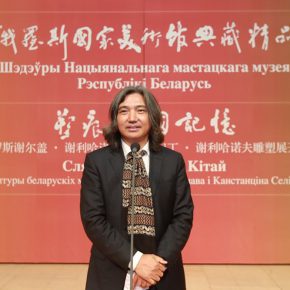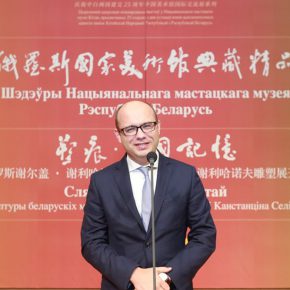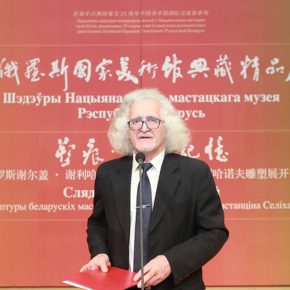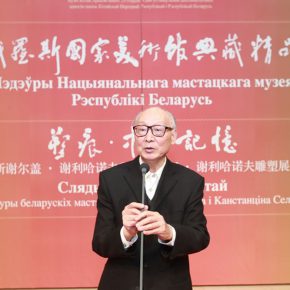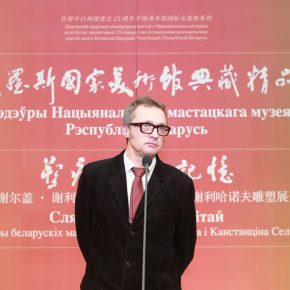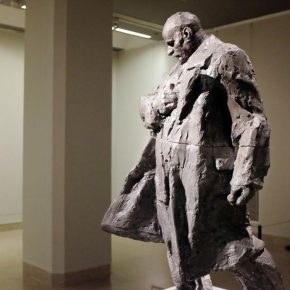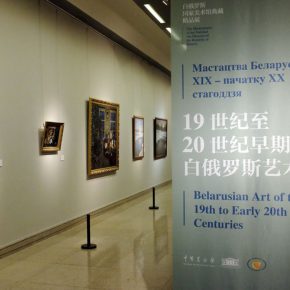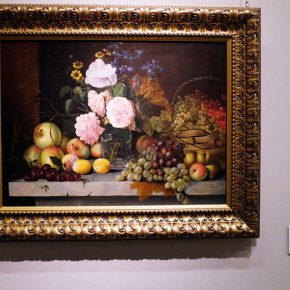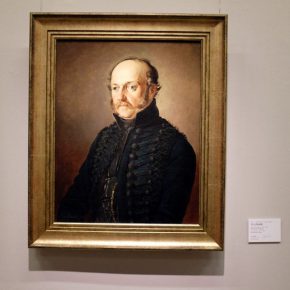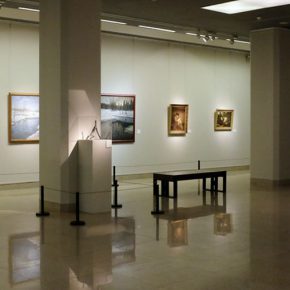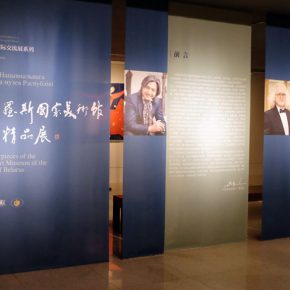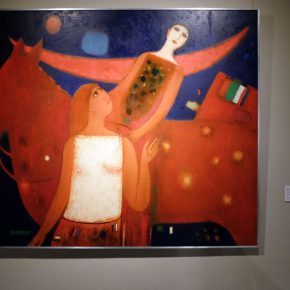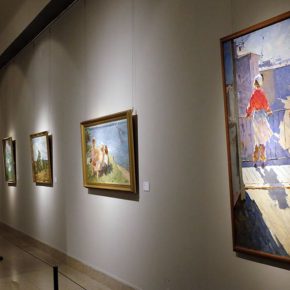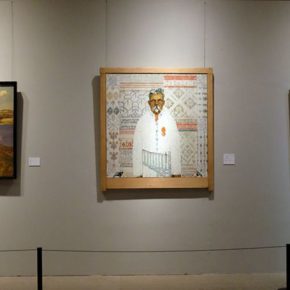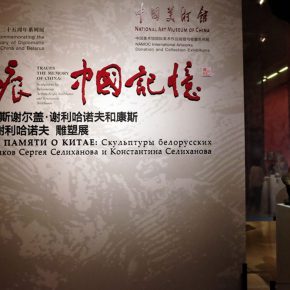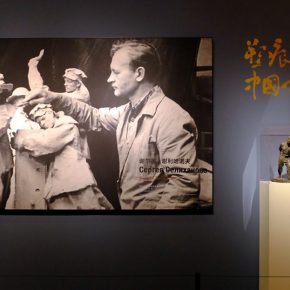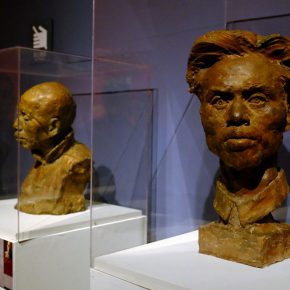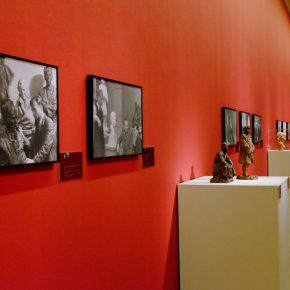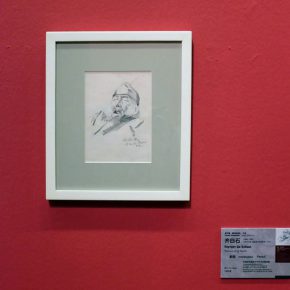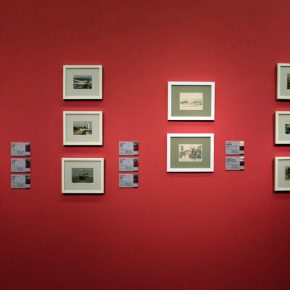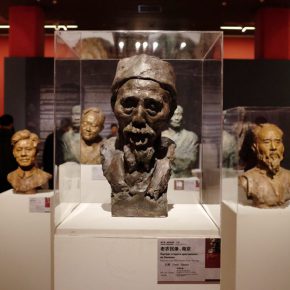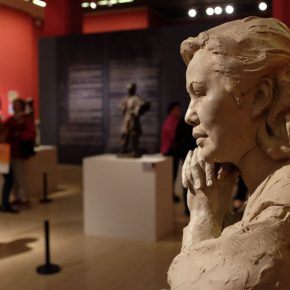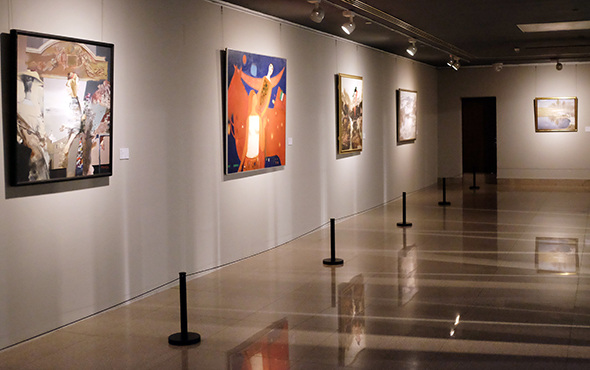
On October 24, 2017, “Masterpieces of National Art Museum of the Republic of Belarus”, which is jointly hosted by the National Art Museum of China and the National Art Museum of the Republic of Belarus, and “Sculpture Mark · China Memory – Sculpture Exhibition of Sergei Selikhanov and Konstantin Selikhanov” was planned and hosted by the National Art Museum of China, both opened at the same time at the National Art Museum of China, on the 25th anniversary of the establishment of diplomatic relations between China and the Republic of Belarus, offering a cultural exchange and dialogue between the two sides.
Masterpieces of the National Art Museum of the Republic of Belarus Debut??“Masterpieces of National Art Museum of the Republic of Belarus” is jointly planned by Wu Weishan, Director of National Art Museum of China, and Uladzimir Prakaptsou, Director of the National Art Museum of the Republic of Belarus, with Katsiaryna Izafatava, Director of the Department of Modern Art in Belarus at the National Art Museum of the Republic of Belarus, serving as the executive curator, after two-years of preparation, the masterpieces of the National Art Museum of the Republic of Belarus are on display at the National Art Museum of China for the first time, with the cooperation of the two art museums.
“Masterpieces of the National Art Museum of the Republic of Belarus” features a total of 57 works from the collections of the National Art Museum of the Republic of Belarus, to present art from Belarus from the 19th century, including portraits, landscape paintings, still life paintings and genre paintings, with the works of different historical periods, different genres, and different styles to complete a clear clue of the development of the art of Belarus.
Russian art is an important component of the collections of?the?National Art Museum of the Republic of Belarus, mainly because the art of Belarus is influenced to a great extent by Russian art. The exhibition begins with the works of outstanding Russian artists of the 19th century and early 20th century, including Realist artists Kramskoi, Repin, Shishkin, Levitan, Mackowski, Nesterov,?Kustodiyev and Serov, who have heavily influenced Belarusian and Chinese oil painting, who are also very well known to a Chinese audience.
Belarusian art has its own unique charm and characteristics. At the press conference, Katsiaryna Izafatava, Director of the Department of Modern Art of Belarus at the National Art Museum of the Republic of Belarus introduced Belarusian artists from the exhibition – some of them were born in Belarus and received art training in St. Petersburg and Moscow, their artistic styles do not only integrate the vigorous and firm techniques of Russian art, but also reflects the characteristics of the fine art of Belarus, such as the Khrutski’s “Roses & Fruits” and “Portrait of a Man”, Bielenicike-Luria’s “One Winter Day”, etc.
In addition, the younger Belarusian artists have developed a new language of Belarusian art on the foundation of these predecessors, and strives to create a further artistic breakthrough, and “especially after the announcement of the independence of the Republic of Belarus in 1991, Belarusian art began to embark on self-renewal and a search for cultural roots, the curator Wu Weishan curator said that this batch of Belarusian artists “have a more open vision, on the one hand absorbing the influence of Western modernism, freely exploring various forms in addition to realism, on the other hand, assimilating the national and folk nourishment, to create many works of a strong national spirit and a modern style, such as Kazakov’s “Belarus”, Kostyuchenker’s “Give Me the Moon”.
Uladzimir Prakaptsou, Director of the National Art Museum of the Republic of Belarus addressed the opening ceremony, and said that: “This magnificent exhibition presents the Chinese audience with unique colors, a rich spiritual world & emotional world of Belarusian fine arts and also demonstrates the inheritance and uniqueness of the great traditions of Belarusian national culture.”
“Sculpture Mark · China Memory”?– Sculpture Exhibition of Sergei Selikhanov and Konstantin Selikhanov????It also holds the “Sculpture Mark · China Memory - Sculpture Exhibition of Sergei Selikhanov and Konstantin Selikhanov” on the same day and displays 53 works from Sergei Selikhanov, and 92 artworks from Konstantin Selikhanov.
At the press conference, Wu Weishan talked about the origin of the show – when he visited Belarusian sculptor Konstantin Selikhanov’s studio in 2016, he saw many sculptures depicting Chinese scholars, including Qi Baishi, Ba Jin, Bai Yang, so he was deeply touched, and then he learned that these sculptures were created by the famous sculptor Sergei Selikhanov, Konstantin Selikhanov’s grandfather.
Sergei Selikhanov once visited China for three months as a foreign expert in November 1956 to January 1957. During that period, he finished many sketches, drawings, watercolors, and small-size works in oil painting, and created a number of figure sculptures for painters and performing artists, including Qi Baishi, Jiang Zhaohe, Li Hua, Bai Yang, as well as ordinary people. Sergei has shaped the aspects of the human world, through the statue to reach the spirit, to practice the artistic expression directed by his realism theory that is in between society and people in China. It presents Chinese sculptural images created by him in the 1950s, to vividly show social images and realistic situations in China at that time.
Born in 1967, Selikhanov inherited the will of his grandfather Sergei Selikhanov in art, while his creation is influenced by the times. The transformation of social structure, the change of ideology, the change of values, the diversity of the ideas & system of artistic creation, offers Konstantin Selikhanov profound & extensive thoughts on philosophical problems and human nature. This thinking has led to his exploration of the form of modern artistic language, while the figurative realism is the only way to carry human emotions and aesthetics. Konstantin pursues the deconstruction & reconstruction of the objective form, and then forms an expression of abstract composition.
Curator Wu Weishan believes that, seen from the art of Sergei Selikhanov and Konstantin Selikhanov, we can see the developmental history of sculptural art in Belarus. It is also the reason why Wu offered a special invitation to Sergei Selikhanov and Konstantin Selikhanov to hold an exhibition at the National Art Museum of China.
“Masterpieces of the National Art Museum of the Republic of Belarus” remains on view till December 17, and the “Mark·China Memory – Sculpture Exhibition of Sergei Selikhanov and Konstantin Selikhanov” continues to October 29.
Text and photo by Lin Jiabin, translated by Chen Peihua and edited by Sue/CAFA ART INFO


